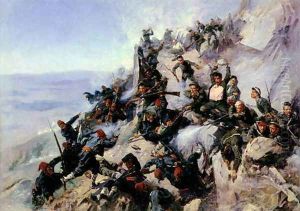Andrei Nikolaevich Popov Paintings
Andrei Nikolaevich Popov was a Russian artist, known for his distinctive style that combined elements of surrealism and abstract art. Born in 1930, Popov's formative years coincided with a period of great political and social upheaval in the Soviet Union. Despite the restrictive environment for artists during this time, which often mandated adherence to socialist realism, Popov managed to develop a unique artistic voice that set him apart from his contemporaries.
Popov's early education in art began at a time when the Soviet regime tightly controlled artistic expression, yet he showed a remarkable ability to absorb a variety of influences while forging his own creative path. He graduated from the Moscow State Academic Art Institute named after V.I. Surikov, which was a leading institution for art education in the USSR. Popov was deeply affected by the works of Russian avant-garde artists as well as Western European art movements, filtering these influences through his own experiences and worldview.
Throughout the 1960s and 1970s, Popov's work began to gain recognition both within the Soviet Union and abroad. His paintings often featured enigmatic, dream-like imagery that seemed to reflect a personal mythology. In a society where censorship was the norm, his art provided a subtle form of resistance through its embrace of individualism and non-conformity.
Despite the challenges faced by artists in the Soviet Union, including limited opportunities for exhibition and the risk of being shunned by official art circles, Popov continued to work prolifically. His works were characterized by a vibrant use of color, imaginative landscapes, and sometimes a sense of whimsy or dark humor. He participated in various group exhibitions, and by the later years of his life, his art had begun to receive the international attention it deserved.
Andrei Nikolaevich Popov's legacy extends beyond his contributions to Russian art; he is remembered as an artist who remained true to his vision despite the constraints of his environment. His paintings can be found in numerous private collections and museums, and his influence can be seen in the works of subsequent generations of Russian artists. Popov passed away in 2007, leaving behind a body of work that continues to inspire and provoke thought.
